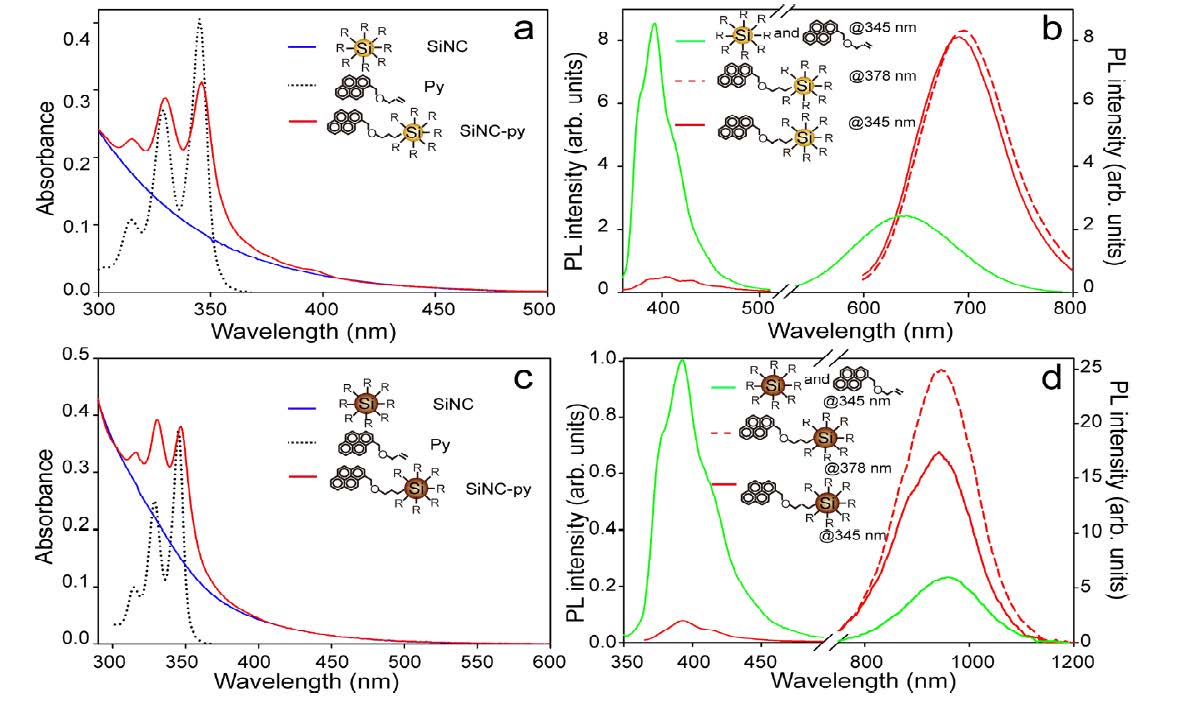Background
Silicon (Si) is an extraordinarily useful semiconductor, employed in integrated circuits, solar cells, and photodetectors; however, it exhibits no significant luminescence at room temperature because of its indirect band gap. Silicon nanocrystals (SiNCs), or quantum dots, on the other hand can be efficient light emitters, with emission wavelength that can be tuned by size from the near-infrared (NIR) into the visible range. Because Si is nontoxic, SiNCs are also well-suited for medical imaging applications.
Technology description
Researchers at The University of Texas at Austin have developed a hydride-terminated SiNCs which were produced by the hydrogen silsequioxane (HSQ) decomposition route of Veinot followed by thermal hydrosilylation with alkenes. The synthetic approach yields clean, well-characterized nanocrystals with reliable control over size, surface passivation, emission color, dispersibility, and photostability. The nanocrystals were passivated with a mixed ligand layer of 1‑dodecene and 1-(allyloxymethyl)pyrene (Py) using Py/dodecene molar ratios ranging between 0.028 (1:12) and 0.083 (1:36) (SiNC-Py). For comparison, SiNCs were also passivated only with 1-dodecene (SiNC).
Results
Two SiNC-Py samples with average Si core diameter of 2.6 and 5.0 nm were examined and used throughout for photophysical characterization. UV-vis-NIR absorbance and photoluminescence (PL) spectra of toluene dispersions of the 2.6 and 5.0 nm diameter SiNC and SiNC-Py are shown below. A full report of this work may be found at https://pubs.acs.org/doi/10.1021/jz501609e.

Fig 1. Absorbance spectra of (a) 2.6 and (c) 5.0 nm diameter SiNC (blue), SiNC-Py (red line), and Py (black dotted line) in air-equilibrated toluene. PL spectra of (b) 2.6 and (d) 5.0 nm diameter SiNC-Py (solid red line, λex = 345 nm; dashed red line, λex = 378 nm) and optically matched solutions of free Py mixed with SiNCs in the appropriate ratio (green lines, λex = 345 nm) in air-equilibrated toluene. To obtain the PL spectra in (b) and (d), the two samples of SiNC-Py photoexcited at 345 and 378 nm are optically matched at the excitation wavelength to enable direct comparison of the emission intensity of the SiNCs when light absorption is dominated by the pyrene moieties or the nanocrystals. In (b) and (d), the y-axis on the left corresponds to the pyrene-related emission, and the y-axis on the right corresponds to the SiNC-related emission.
| d/nm | λex /nm | λem /nm | φema | τ/nsb |
SiNC | 2.6 | 378 | 635 | 0.11 | 70 × 103 |
SiNC-Py | 2.6 | 345 | 400 | 0.005 | <0.2, 5 |
| | 378 | 680 | 0.8 | 95 × 103 |
Py | | 345 | 400 | 0.06 | 18 |
SiNC | 5.0 | 378 | 970 | 0.45 | 150 × 103 |
SiNC-Py | 5.0 | 345 | 400 | 0.005 | <0.2, 5 |
| | 378 | 970 | 0.40 | 190 × 103 |
a Experimental error: 10%
b Experimental error: 5%
Table 1. Photophysical properties of SiNC and SiNC-Py dispersed in air-equilibrated toluene at 298°K along with model compound Py for comparison.

